Sony SNC-DH280, SNC-DH240, SNC-DH140, SNC-DH140-R, SNC-DH140T Quick User Guide
...
4-174-237-19 (1)
Network Camera
User’s Guide
Software Version 1.85
Before operating the unit, please read this manual thoroughly and retain it for future reference.
SNC-CH135/CH140/CH180/CH240/CH280 SNC-DH140/DH140T/DH180/DH240/DH240T/DH280
© 2009 Sony Corporation

Table of Contents |
|
Overview |
|
Features .................................................................. |
4 |
How to Use This User’s Guide .............................. |
5 |
System Requirements ............................................ |
6 |
Preparation |
|
Assigning the IP Address to the Camera ............ |
7 |
Assigning an IP address using SNC toolbox |
..... 7 |
Accessing the Camera Using the Web |
|
Browser ................................................................... |
8 |
Basic Configuration by the Administrator ....... |
10 |
Precautions for Preventing Access to the Camera |
|
by an Unintended Third Party ........................... |
11 |
How to set up ................................................... |
11 |
Operating the Camera |
|
Administrator and User ...................................... |
12 |
Logging in to System ........................................... |
13 |
Logging in as a user ......................................... |
13 |
About Viewers ................................................. |
13 |
Configuration of Main Viewer ........................... |
14 |
Main menu ....................................................... |
14 |
Control panel section ....................................... |
14 |
Monitor image .................................................. |
16 |
Plug-in free viewer ........................................... |
17 |
Using Solid PTZ function ................................ |
17 |
Controlling via the control panel (Operation |
|
common to Area zoom mode and Vector |
|
dragging mode) .............................................. |
18 |
Panning and tilting by clicking the monitor image |
|
(Area zoom mode only) ................................. |
18 |
Panning, tilting and zooming by specifying the |
|
area (Area zoom mode only) .......................... |
18 |
Panning and tilting by dragging the screen (Vector |
|
dragging mode only) ...................................... |
19 |
Moving the camera to a preset position (Common |
|
operations in Area zoom and Vector dragging |
|
modes) ............................................................ |
19 |
Using pan/tilt/zoom operations with the displayed |
|
control bar (PTZ Control bar only) ................ |
19 |
Controlling the Camera on a Full Image .......... |
19 |
Using the Trigger Button .................................... |
20 |
Sending a monitor image via e-mail ................ |
20 |
Sending a monitor image to an FTP server ...... |
20 |
Recording a camera image as a still image ...... |
20 |
Controlling Alarm out 1, 2 ............................... |
21 |
Controlling the Day/Night function .................. |
21 |
Playing an audio file stored in the camera ........ |
21 |
Switching Transmission Mode ............................ |
21 |
Using the System Utility ...................................... |
22 |
SNC viewer ....................................................... |
22 |
SNC Desktop viewer ........................................ |
23 |
Administrating the Camera |
|
Basic Operations of the Administrator Menu ... |
25 |
How to set up the Administrator menu ............. |
25 |
Configuration of the Administrator menu ........ |
26 |
Configuring the System — System Menu .......... |
27 |
System Tab ....................................................... |
27 |
Date & time Tab ............................................... |
28 |
Superimpose Tab .............................................. |
29 |
Installation Tab ................................................. |
30 |
Initialize Tab ..................................................... |
31 |
System log Tab ................................................. |
33 |
Access log Tab .................................................. |
33 |
Setting the Camera Image and Audio |
|
— Camera Menu .................................................. |
33 |
Common Tab .................................................... |
33 |
Focus tab — Adjusting the Focus (SNC-CH240/ |
|
CH135/CH140 only) ....................................... |
34 |
Focus/Zoom tab — Adjusting the focus/zoom |
|
(SNC-CH180/CH280/DH140/DH180/DH240/ |
|
DH280 only) ................................................... |
34 |
Picture Tab ........................................................ |
35 |
Privacy masking tab .......................................... |
36 |
Day/Night Tab .................................................. |
37 |
Video codec Tab ............................................... |
38 |
Streaming Tab ................................................... |
42 |
Configuring the Network — Network Menu ..... |
43 |
Network Tab ..................................................... |
43 |
Wireless Tab — Setting of wireless connection |
|
(SNC-CH240/CH135/CH140/CH180/CH280 |
|
only) ................................................................ |
44 |
QoS Tab ............................................................ |
47 |
Dynamic IP address notification Tab — Notifying |
|
the IP Address ................................................. |
49 |
Setting the SSL function — SSL Menu .............. |
51 |
Common tab ..................................................... |
51 |
CA certificate tab — Adding the CA certificate for |
|
client authentication ........................................ |
53 |
How to install the CA certificate ...................... |
54 |
To remove an installed CA certificate .............. |
55 |
Using the 802.1X Authentication Function |
|
— 802.1X Menu .................................................... |
56 |
System configuration of 802.1X network ........ |
56 |
Common Tab — Basic setting of 802.1X |
|
authentication function ................................... |
57 |
Client certificate Tab ........................................ |
58 |
2 Table of Contents

CA certificate Tab ............................................ |
59 |
Setting the 802.1X authentication function |
|
— Example of Windows Server 2003 ........... |
59 |
Setting the User — User Menu ........................... |
62 |
Setting the Security — Security Menu .............. |
63 |
Setting Tab ....................................................... |
63 |
Referer check tab .............................................. |
64 |
Saving the Camera Position and Action — Preset |
|
position Menu ...................................................... |
65 |
Position Tab — Saving pan/tilt/zoom |
|
position ........................................................... |
65 |
Preset tour Tab — Setting a position tour ........ |
66 |
Sending an Image via E-mail — e-Mail (SMTP) |
|
Menu ..................................................................... |
68 |
Common Tab — Setting the e-Mail (SMTP) |
|
Function .......................................................... |
68 |
Alarm sending Tab — Setting the e-mail sending |
|
mode when detecting the alarm ...................... |
69 |
Periodical sending Tab — Setting the periodical |
|
e-mail sending mode ...................................... |
70 |
Sending Images to FTP Server — FTP client |
|
Menu ..................................................................... |
71 |
Common Tab — Setting the FTP client |
|
function .......................................................... |
71 |
Alarm sending Tab — Setting the FTP client |
|
action when detecting the alarm ..................... |
72 |
Periodical sending Tab — Setting the periodical |
|
FTP client activity .......................................... |
73 |
Recording Images in Memory — Image memory |
|
Menu ..................................................................... |
74 |
Common Tab — Setting the image memory |
|
function .......................................................... |
75 |
Alarm recording Tab — Setting the Image |
|
memory function when detecting the |
|
alarm ............................................................... |
76 |
Periodical recording Tab — Setting the periodical |
|
recording mode ............................................... |
77 |
Folder structure of image memory ................... |
78 |
Downloading Images from the Camera — FTP |
|
server Menu ......................................................... |
79 |
Setting the Edge Storage — Edge Storage |
|
Menu ..................................................................... |
79 |
Folder structure of Edge Storage ...................... |
81 |
Setting the Alarm Output — Alarm output |
|
Menu ..................................................................... |
81 |
Alarm out 1, 2 Tab ........................................... |
81 |
Outputting Audio Linked to Alarm Detection |
|
— Voice alert Menu ............................................. |
82 |
Voice alert 1, 2, 3 Tab ...................................... |
82 |
Setting the Operations from the Viewer |
|
— Trigger Menu .................................................. |
83 |
Setting the Schedule — Schedule Menu ............ |
85 |
Setting the Alarm Buffer — Alarm buffer |
|
Menu ...................................................................... |
86 |
Setting the Sensor input/Camera tampering |
|
detection/Motion detection/Audio detection |
|
— Event detection Menu ..................................... |
86 |
Sensor input tab — Set the sensor input ........... |
86 |
Camera tampering detection tab — Set the camera |
|
tampering detection ........................................ |
86 |
Motion detection tab — Set the motion/VMF |
|
detection .......................................................... |
87 |
What are VMF functions .................................. |
87 |
Setting items for motion detection .................... |
88 |
VMF settings ..................................................... |
89 |
Audio detection tab — Set the audio |
|
detection .......................................................... |
93 |
Configuring the Viewer — Viewer Menu .......... |
94 |
Layout tab ......................................................... |
94 |
HTML output tab .............................................. |
97 |
Others |
|
Using the SNC toolbox ......................................... |
98 |
Using the SNC audio upload tool — Transmitting |
|
Audio to Camera .................................................. |
98 |
Using the SNC video player — Playing a Video/ |
|
Audio File Recorded with the Camera ............... |
99 |
Installing the SNC video player ........................ |
99 |
Using the SNC video player ............................. |
99 |
Using the SNMP ................................................. |
100 |
1. Inquiry Commands ..................................... |
100 |
2. Setting Commands ...................................... |
101 |
Glossary .............................................................. |
102 |
Index .................................................................... |
105 |
Table of Contents |
3 |
|
|

Overview
Overview
Features
•High-quality Full HD (1080P) real-time monitoring, up to 30 fps. (SNC-CH240/DH240/CH280/DH280)
•High-quality HD (720P) live images from camera can be monitored at a maximum frame rate of 30 fps.
•High quality real-time streaming, up to image size 1920 × 1440. (SNC-CH240/DH240/CH280/DH280)
•Live images can be streamed in high-quality with maximum SXGA (1280 × 1024) image size.
•Exmor CMOS sensor enables high-quality images for streaming.
•View-DR and Visibility Enhancer enable clearer images for streaming in the high contrast environment.
•XDNR enables clearer images for streaming in the low lightness environment.
•Three video compression modes (video codecs) JPEG/MPEG4/H.264 are supported.
•Single codec mode and dual codec mode are available.
•Easy Focus enables easier focus adjustment when it is installed.
•Easy Zoom function enables remote adjustment of view angle after installation. (SNC-CH180/CH280/ DH140/DH180/DH240/DH280)
•IR illuminator enables monitoring 0 lux lighting condition up to 20 meters. (SNC-CH180/DH180/ CH280/DH280 only)
•Inserting the optional wireless card SNCA-CFW5* enables wireless transmission of camera images. (SNC-CH240/CH135/CH140/CH180/CH280**)
•Insert the SNCA-CFW5* into the slot and attach the optional wireless LAN antenna SNCA-AN1* to the camera to extend the communicable distance by wireless LAN. (SNC-CH135/CH140/CH240)
•An optional CF memory card allows you to save images. (SNC-CH240/CH135/CH140/CH180/ CH280**)
•“Edge Storage” for recording of video or audio signal based on alarm detection (such as network block), and same protocol real-time image streaming.
(SNC-CH240/CH135/CH140/CH180/CH280**)
•Motion detection, camera tampering detection and audio detection functions.
•High-performance Echo Canceler purely eliminates acoustic echo propagated from a loudspeaker to a microphone of the camera.
•Ambient noise filter reduces noise for clear sound streaming.
•Dynamic Range Compressor for optimal audio streaming.
•Up to 10 users can view images from one camera at the same time.
•Date/time can be superimposed on the image.
• PoE (Power over Ethernet) compliant.
*SNCA-CFW5 and SNCA-AN1 are not available in some countries and areas. For details, contact your
authorized Sony dealer.
**Not available for SNC-CH180/CH280 when powered by PoE.
4 Features

NOTICE TO USERS
© 2009 Sony Corporation. All rights reserved. This manual or the software described herein, in whole or in part, may not be reproduced, translated or reduced to any machine readable form without prior written approval from Sony Corporation.
SONY CORPORATION PROVIDES NO WARRANTY WITH REGARD TO THIS MANUAL, THE SOFTWARE OR OTHER INFORMATION CONTAINED HEREIN AND HEREBY EXPRESSLY DISCLAIMS ANY IMPLIED WARRANTIES OF MERCHANTABILITY OR FITNESS FOR ANY PARTICULAR PURPOSE WITH REGARD TO THIS MANUAL, THE SOFTWARE OR SUCH OTHER INFORMATION. IN NO EVENT SHALL SONY CORPORATION BE LIABLE FOR ANY INCIDENTAL, CONSEQUENTIAL OR SPECIAL DAMAGES, WHETHER BASED ON TORT, CONTRACT, OR OTHERWISE, ARISING OUT OF OR IN CONNECTION WITH THIS MANUAL, THE SOFTWARE OR OTHER INFORMATION CONTAINED HEREIN OR THE USE THEREOF.
Sony Corporation reserves the right to make any modification to this manual or the information contained herein at any time without notice.
The software described herein may also be governed by the terms of a separate user license agreement.
•“IPELA” and  are trademarks of Sony Corporation.
are trademarks of Sony Corporation.
• is trademark of Sony Corporation.
is trademark of Sony Corporation.
•“Exmor” and  are trademarks of Sony Corporation.
are trademarks of Sony Corporation.
•Microsoft, Windows, Internet Explorer and Microsoft DirectX are registered trademarks of Microsoft Corporation in the United States and/or other countries.
•Java is a trademark of Sun Microsystems, Inc. in the United States and other countries.
•Intel and Pentium are registered trademarks of Intel Corporation or its subsidiaries in the United States and other countries.
•Adobe, Adobe Reader and Adobe Flash are trademarks of Adobe Systems Incorporated in the United States and/or other countries.
•CompactFlash and CF are trademarks of SanDisk Corporation, registered in the United States and other countries.
All other company and product names are trademarks or registered trademarks of the respective companies or their respective makers.
How to Use This User’s Guide
This User’s Guide explains how to operate the Network Camera from a computer.
The User’s Guide is designed to be read on the computer display.
This section gives tips on making the most of the User’s Guide-read it before you operate the camera.
Jumping to a related page
When you read the User’s Guide on the computer display, you can click on a sentence to jump to a related page.
Software display examples
Note that the displays shown in the User’s Guide are explanatory examples. Some displays may be different from the ones that appear in actual use.
The illustrations of the camera and menu display in the User’s Guide show the SNC-CH140, SNC-DH140 or SNC-DH180, SNC-DH280 as an example.
Printing the User’s Guide
Depending on your system, certain displays or illustrations in the User’s Guide, when printed out, may differ from those that appear on your screen.
Installation Manual (printed matter)
The supplied Installation Manual describes the names and functions of parts and controls of the Network Camera, connection examples, and how to set up the camera. Be sure to read the Installation Manual before hand.
About model name
SNC-DH240T and SNC-DH140T are indicated as SNC-DH240 and SNC-DH140 respectively in this manual, due to the similarities of the functions.
Overview
How to Use This User’s Guide 5

Overview
System Requirements
The following computer environment is necessary for the computer to display images and the controls of the camera.
(November 2014)
Common
OS
Microsoft Windows XP, Windows Vista (32bit version only), Windows 7 (32-bit version, 64-bit version), Windows 8 Pro (32-bit version, 64-bit version)*, Windows 8.1 Pro (32-bit version, 64-bit version)* Authorized editions:
Windows XP: Professional Windows Vista: Ultimate, Business Windows 7: Ultimate, Professional Windows 8: Pro
Windows 8.1: Pro
Microsoft DirectX 9.0c or higher
Web Browser
Windows Internet Explorer Ver. 7.0, Ver. 8.0, Ver. 9.0, Ver. 10.0*
Firefox Ver. 25.0 (Plug-in free viewer only) Safari Ver. 5.1 (Plug-in free viewer only)
Google Chrome Ver. 31.0 (Plug-in free viewer only)
SNC-CH135/CH140/CH180/DH140/DH180
CPU
Intel Core 2 Duo, 2 GHz or higher
Memory
1 GB or more
Display
1600 × 1200 pixels or higher
SNC-CH240/DH240/CH280/DH280
CPU
Intel Core 2 Duo, 2.33 GHz or higher
Memory
2 GB or more
Display
1600 × 1200 pixels or higher
(2560 × 1600 pixels or higher is recommended)
*In case of Windows 8 or Windows 8.1, use the Internet Explorer desktop user interface (desktop UI) edition.
6 System Requirements

Preparation
The Preparation section explains what the administrator has to prepare for monitoring images after installation and connection of the camera.
Assigning the IP Address to the Camera
To connect the camera to a network, you need to assign a new IP address to the camera when you install it for the first time.
Before starting, connect the camera, referring to “Connecting the Camera to a Local Network” in the supplied Installation Manual.
Consult the administrator of the network about the assigned IP address.
Assigning an IP address using SNC toolbox
1 Insert the CD-ROM in your CD-ROM drive.
A cover page appears automatically in your Web browser.
If it does not appear automatically in the Web browser, double-click the index.htm file on the CD-ROM.
When you are using Windows Vista, the “Auto play” pop-up may appear.
2 Click the Setup icon of SNC toolbox. The “File Download” dialog appears.
3 Click File Open.
4 Install “SNC toolbox” on your computer using the wizard.
For details of the software installation and usage, see the Application Guide.
5 Assign the IP address.
Assign the IP address using the installed SNC toolbox.
For details, see “Using the SNC toolbox” - “Assigning an IP address” in the Application Guide.
Tips
•Download the latest installer or Application Guide of SNC toolbox from the following URL: http://www.sony.net/ipela/snc
•SNC toolbox stands for Sony Network Camera toolbox.
Preparation
Assigning the IP Address to the Camera |
7 |
|
|
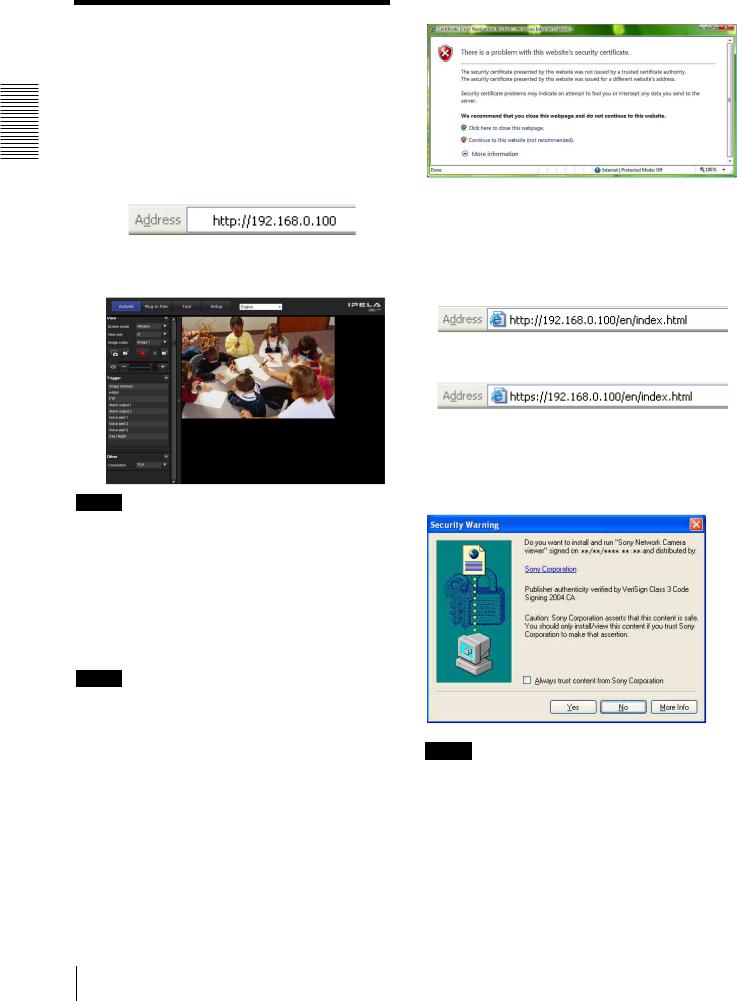
Preparation
Accessing the Camera
Using the Web Browser
After the IP address has been assigned to the camera, check that you can actually access the camera using the Web browser installed on your computer.
Use Internet Explorer as a Web browser.
1 Start the Web browser on the computer and type the IP address of the camera in the URL address bar.
The viewer window is displayed.
Display sample
Note
When accessing the camera, images will not be displayed in the following conditions.
•When the maximum number of viewers exceeds 10 However, if the e-Mail (SMTP) function or the FTP client function is set to On, the maximum number of viewers will be 3.
•The bit rate including new requests exceeds 16Mbps
Using the SSL function
Note
The model on sale in China does not support the SSL function.
When Internet Explorer is used
When you enter the camera IP address, “Certificate Error” may appear according to the status of the certificate set on the camera. In this case, click
Continue to this website (not recommended). to continue.
The welcome page appears (in SSL communication).
When “Allow HTTP connection for some clients” (page 51) is checked
To use HTTP and SSL connections separately to access, enter the following in the address box of the browser.
For HTTP connection
For SSL connection
When the viewer of the camera is displayed for the first time
“Security Warning” is displayed. When you click Yes, ActiveX control is installed and the viewer is displayed.
Notes
•If Automatic configuration is enabled in the Local Area Network (LAN) settings of Internet Explorer, the image may not be displayed. In that case, disable
Automatic configuration and set the proxy server manually. For the setting of the proxy server, consult your network administrator.
•When you install ActiveX Control, you should be logged in to the computer as Administrator.
8 Accessing the Camera Using the Web Browser

Tip
The software is optimized for Internet Explorer using medium font.
To display the viewer correctly
To operate the viewer correctly, set the security level of Internet Explorer to Medium or lower, as follows:
1 Select Tools from the menu bar for Internet Explorer, then select Internet Options and click the Security tab.
2 Click the Internet icon (when using the camera via the Internet), or Local intranet icon (when using the camera via a local network).
3 Set the slider to Medium or lower. (If the slider is not displayed, click Default Level.)
When using antivirus software, etc., on the computer
•When you use antivirus software, security software, personal firewall or pop-up blocker on your computer, the camera performance may be reduced, for example, the frame rate for displaying the image may be lower.
•The Web page displayed when you log in to the camera uses JavaScript. The display of the Web page may be affected if you use antivirus software or other software described above on your computer.
Preparation
Accessing the Camera Using the Web Browser 9

Preparation
Basic Configuration by the Administrator
You can monitor the camera image by logging in with the initial conditions set for this network camera. You can also set various functions according to the installing position, network conditions or purpose of the camera. We recommend you configure the following items before monitoring images from the camera.
Setting contents |
Setting menu |
|
|
Set the format of the image sent from the camera. |
Video codec Tab (page 38) |
|
|
Select the White Balance mode according to the installation position. |
White balance (page 36) |
|
|
Select the brightness of the image sent from the camera. |
Exposure (page 35) |
|
Brightness (page 36) |
|
|
Select the quality of the image sent from the camera. |
Video codec Tab (page 38) |
|
|
Select the view size of the image. |
View size (page 14) |
|
|
Select whether the audio from the external microphone is sent or not. |
Audio codec (page 33) |
|
|
Synchronize the date and time of the camera with those of the computer. |
Date & time Tab (page 28) |
|
|
Make the setting for sending the monitor image attached to an e-mail. |
e-Mail (SMTP) Menu (page 68) |
|
|
Set the user access right for the camera. |
User Menu (page 62) |
|
|
Set a place to be watched beforehand. |
Preset position Menu (page 65) |
|
|
Prepare a panorama image. |
To create a full image (page 19) |
|
|
10 Basic Configuration by the Administrator

Precautions for Preventing Access to the Camera by an Unintended Third Party
The camera may be accessed by an unintended third party on the network, depending on the usage environment. Changing the user name and password of the camera administrator from the default settings is highly recommended for security reasons. If the camera is accessed by an unintended third party, there may be an undesired effect, such as operations or settings to block monitoring, etc.
The camera can be fraudulently accessed in a network environment where a device is connected or connectable to the network without the administrator's permission, or a PC or other network device connected to the network can be used without any permission. Connect to these environments at your own risk. To prevent unauthorized access to the camera, set it according to the following steps.
Do not use the browser you use to set the camera to access other websites while you set or after setting the camera. You will remain logged in to the camera as long as the browser is open, so to prevent an unintended third party's use or execution of malicious programs, close the browser after you finish setting the camera.
How to set up
1 Set the network address of the camera using SNC toolbox.
For details about how to use SNC toolbox, refer to the application guide.
After this step, do not use SNC toolbox to change the network settings of the camera. Use SNC toolbox to search for the camera only.
2 Start the web browser and set the SSL function to Enable in the camera settings.
For details, refer to “Setting the Security — Security Menu” in the Administrator menu on page 63.
3 Restart the web browser and access the camera again.
4 Set the user name and password of the administrator of the camera.
For details, refer to “Setting the Security — Security Menu” in the Administrator menu on page 63.
5 Check the Referer check checkbox.
For details, refer to “Setting the Security — Security Menu” in the Administrator menu on page 63.
6 When you use the e-Mail (SMTP) function, set the TLS function to On. Use a mail server that supports the TLS function.
For details, refer to “Sending an Image via E-mail
— e-Mail (SMTP) Menu” in the Administrator menu on page 68.
Hereafter, use the camera using the SSL connection. When you use the FTP server or the FTP client function, use them in an environment where the network cannot be intercepted by a third party. The SSL connection cannot be used for the FTP server or the FTP client function.
Note
The model on sale in China does not support the SSL function.
Preparation
Precautions for Preventing Access to the Camera by an Unintended Third Party |
11 |
|
|

Operating the Camera
Administrator and User
Camera the Operating
This section explains how to monitor the image from the camera using your Web browser (Internet Explorer).
The functions of the camera should be set by the Administrator. For the setting of the camera, see “Administrating the Camera” on page 25.
Each type of user can use the corresponding functions below.
This network camera identifies those who log in as the
Administrator or User.
The Administrator can use all the functions of this network camera, including camera settings. The User can use the functions for monitoring the image and audio from the camera, and control the camera. The Viewer mode setting is used to restrict the user’s access rights. There are five types of users.
|
|
|
|
User |
|
|
|
Function |
Administrator |
|
|
|
|
|
|
Full |
Pan/Tilt |
Preset |
Light |
View |
|||
|
|
|
|
position |
|
|
|
|
|
|
|
|
|
|
|
Monitor a live image |
z |
z |
z |
z |
z |
z |
|
|
|
|
|
|
|
|
|
View the date and time |
z |
z |
z |
z |
z |
z |
|
|
|
|
|
|
|
|
|
Control the frame rate (JPEG mode only) |
z |
z |
– |
– |
– |
– |
|
|
|
|
|
|
|
|
|
Control the image view size |
z |
z |
z |
z |
z |
– |
|
|
|
|
|
|
|
|
|
Save a still image and movie in the computer |
z |
z |
z |
z |
z |
– |
|
|
|
|
|
|
|
|
|
Send an image file to the FTP server |
z |
z |
– |
– |
– |
– |
|
|
|
|
|
|
|
|
|
Send an image attached to an e-mail |
z |
z |
– |
– |
– |
– |
|
|
|
|
|
|
|
|
|
Record an image in the memory |
z |
z |
– |
– |
– |
– |
|
|
|
|
|
|
|
|
|
Control the alarm output of the I/O port on the camera |
z |
z |
– |
– |
– |
– |
|
|
|
|
|
|
|
|
|
Switch the Day/Night function mode |
z |
z |
– |
– |
– |
– |
|
|
|
|
|
|
|
|
|
Play an audio file (Voice alert) |
z |
z |
– |
– |
– |
– |
|
|
|
|
|
|
|
|
|
Switch the TCP/UDP transmission mode (Available in |
z |
z |
– |
– |
– |
– |
|
MPEG4/H.264 mode only) |
|||||||
|
|
|
|
|
|
||
|
|
|
|
|
|
|
|
Call the preset position |
z |
z |
z |
z |
– |
– |
|
|
|
|
|
|
|
|
|
Perform the pan/tilt/zoom operation |
z |
z |
z |
– |
– |
– |
|
|
|
|
|
|
|
|
|
Receive audio |
z |
z |
z |
z |
z |
z |
|
|
|
|
|
|
|
|
|
Select the codec mode |
z |
z |
z |
z |
z |
– |
|
|
|
|
|
|
|
|
|
Control the setting menu |
z |
– |
– |
– |
– |
– |
|
|
|
|
|
|
|
|
z Usable function
– Not usable function
The access rights of the administrator and the user can be set in “Setting the User — User Menu” of the Administrator menu on page 62.
12 Administrator and User
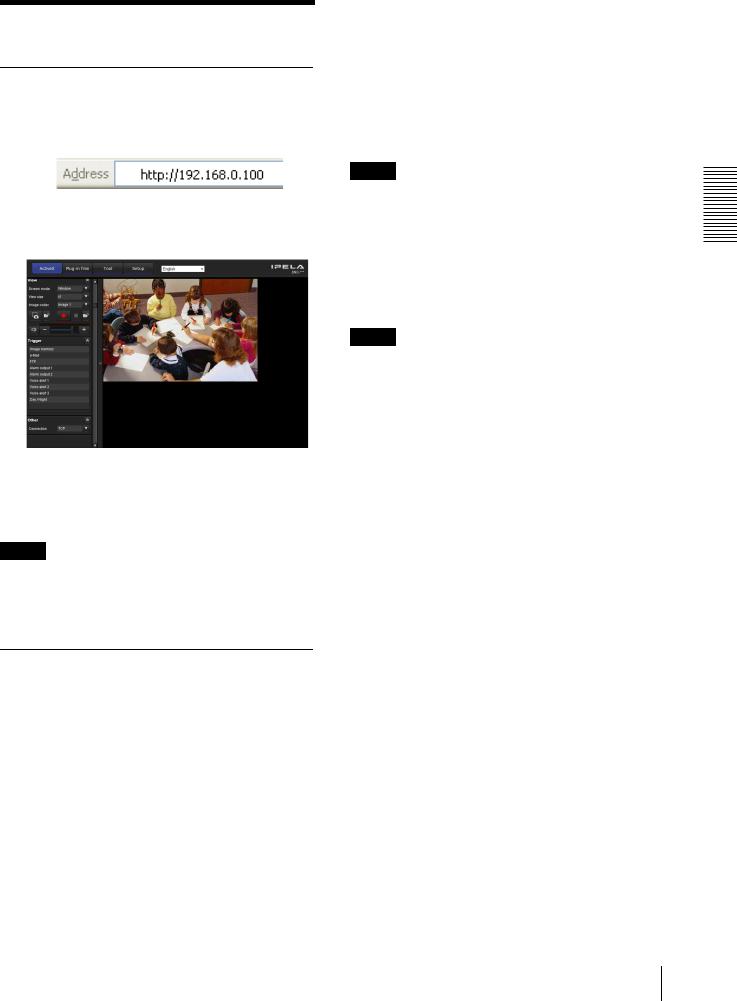
Logging in to System
Logging in as a user
1 Start the Web browser on your computer and type the IP address of the camera you want to monitor.
The viewer is displayed.
Display sample:
Three types of viewer are available: ActiveX viewer, Plug-in free viewer and custom homepage. By default, ActiveX viewer is displayed. To switch the viewer, make changes to the Viewer menu (page 94).
Note
If the main viewer does not start correctly, the security level of the Internet Explorer may be set to higher than Medium. See “To display the viewer correctly” on page 9 and check the security level.
About Viewers
You can use the following viewers.
ActiveX viewer
This viewer can monitor the camera image in any of the JPEG, MPEG4 and H.264 video codecs.
You must install this viewer when you access the main viewer for the first time.
When you display the main viewer of the camera for the first time
When you access the network camera using ActiveX viewer for the first time, the Security Warning appears. Click Yes and install ActiveX Control. You can use all the functions of the viewer with ActiveX Control.
Plug-in free viewer
This viewer allows the user to select from three image display methods: JPEG, JPEG/Flash or ActiveX viewer. JPEG method: JPEG images will be displayed in sequence.
JPEG/Flash method: JPEG images will be displayed in sequence. Adobe Flash is required to display the image. ActiveX viewer method: The image can be viewed when the image display is set to JPEG, MPEG4 or H.264.
Notes
•If Automatic configuration is enabled in the Local Area Network (LAN) Settings of Internet Explorer, the camera image may not be displayed. In that case, disable Automatic configuration and set the proxy server manually. For the setting of the proxy server, consult your network administrator.
•When you install ActiveX Control, you should be logged in to the computer as the Administrator.
Tip
Every page of this software is optimized for Internet Explorer in Medium font.
Camera the Operating
Logging in to System 13
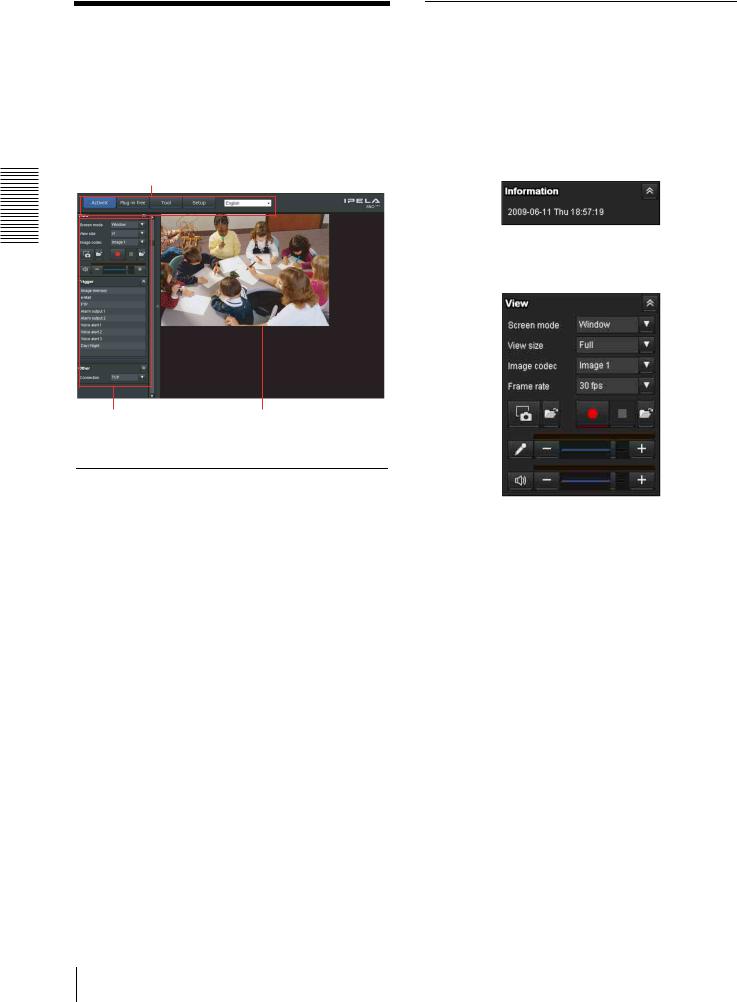
Configuration of Main
Viewer
This section explains the functions of the parts and controls of the main viewer. For a detailed explanation on each part or control, see the specified pages.
Main viewer using ActiveX viewer
Main menu
Camera the Operating
Control panel |
Monitor image |
section |
section |
Main menu
ActiveX
Displays the ActiveX viewer.
Plug-in free
Displays the Plug-in free viewer.
Tool
You can download system utility from here. (page 22) This operation is only available when you are logged in as administrator.
Setup
Click to display the Administrator menu. (page 25) You can operate this function only when logging in as the administrator.
Language
Set language from pull-down.
Control panel section
You can drag the panels to the monitor screen and configure them.
To return to the operation panel, drag the panel and configure the operation panel.
Click the  to hide the detail setting menu or click it again to show the menu.
to hide the detail setting menu or click it again to show the menu.
Information panel
Check the date and time here.
View panel
You can change the screen mode, size of the image, image codec mode and frame rate. Also, still images and movies can be saved (movie saving can also be stopped) from here. Microphone and audio output levels can be adjusted.
Screen Mode
Select Window or Full Screen.
View size
Selects the view size to be displayed.
Click View size list box to select the view size. Select x1 to display images set in Image size of the Camera menu. (page 39)
Select Full to display images according to the view size. Select Fit to display images according to the view size, with fixed aspect ratio.
Image Codec
Select an image codec mode.
Frame rate
(Displayed only when the camera image is in JPEG.) Selects the frame rate to transmit images.
14 Configuration of Main Viewer
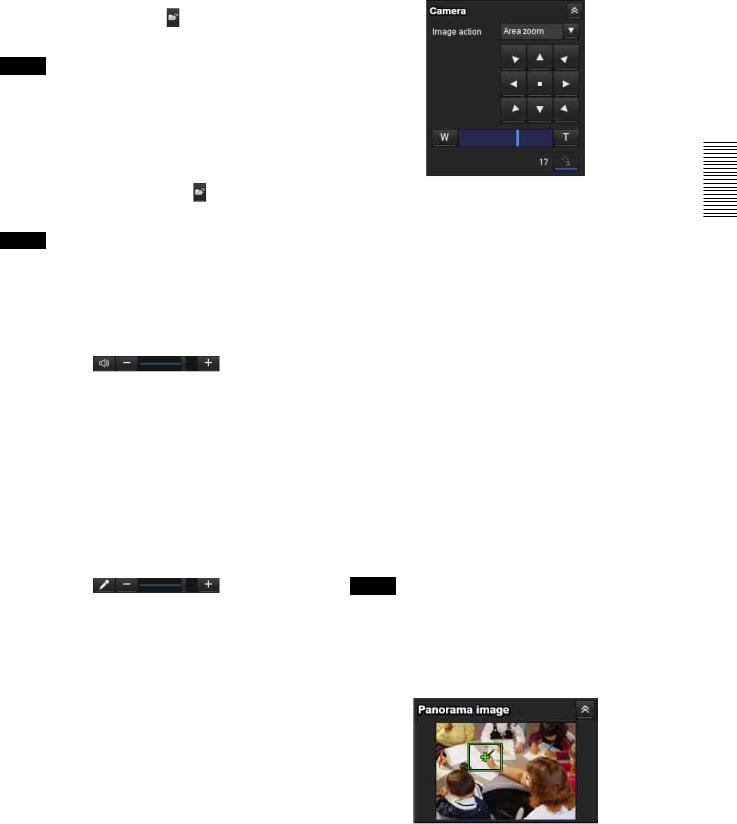
 (Capture)
(Capture)
Click to capture a still image shot by the camera and to store it in the computer. Click to open the folder to be saved.
Note
In the case of Windows Vista, Windows 7, Windows 8 or Windows 8.1, if “Enable Protected Mode” is checked in Control Panel-Internet Option-Security, still images cannot be shot.
 (Run)/
(Run)/ (Stop Save Video)
(Stop Save Video)
Runs and stops Save Video. Click |
to open the folder |
to be saved. |
|
Note
In the case of Windows Vista, Windows 7, Windows 8 or Windows 8.1, if “Enable Protected Mode” is checked in Control Panel-Internet Option-Security, video content cannot be saved.
Volume
Use the slide bar to adjust the volume for sound output level.
When you click  , the icon changes to
, the icon changes to  and the output from the speaker stops. To output sound from the speaker, click
and the output from the speaker stops. To output sound from the speaker, click  again.
again.
Microphone volume
This is displayed when Audio codec (page 33) in the Common tab of the Camera menu is set to On, and a user with audio enabled in the User Menu accesses the device.
Use the slide bar to adjust the microphone volume.
When you click  , the icon changes to
, the icon changes to  and the microphone input stops. To input the microphone, click
and the microphone input stops. To input the microphone, click  again.
again.
Camera control panel
This panel allows you to control the camera’s pan/tilt/ home position and zoom (page 18). In addition, you can obtain authority to operate the camera in exclusive control mode.
Image action
Select the mode of operation from Off, Area zoom and
Vector dragging.
Pan/Tilt control
Click the arrow button the direction in which you want to move the camera. Keep it pressed to move the camera continuously.
To return to the home position, click  .
.
Zoom control
Press  to zoom out, and press
to zoom out, and press  to zoom in. Zooming continues while the button remains pressed.
to zoom in. Zooming continues while the button remains pressed.
 Exclusive control
Exclusive control
Click this button to display the time remaining for operation authority. However, if operation authority has not been obtained, the waiting time is displayed.
Note
Set the Exclusive control mode in the System Tab of the System Menu to On to perform exclusive control (page 27).
Panorama panel
If you click on the Panorama panel, the image of that place is displayed on the monitor.
Camera the Operating
Configuration of Main Viewer |
15 |
|
|
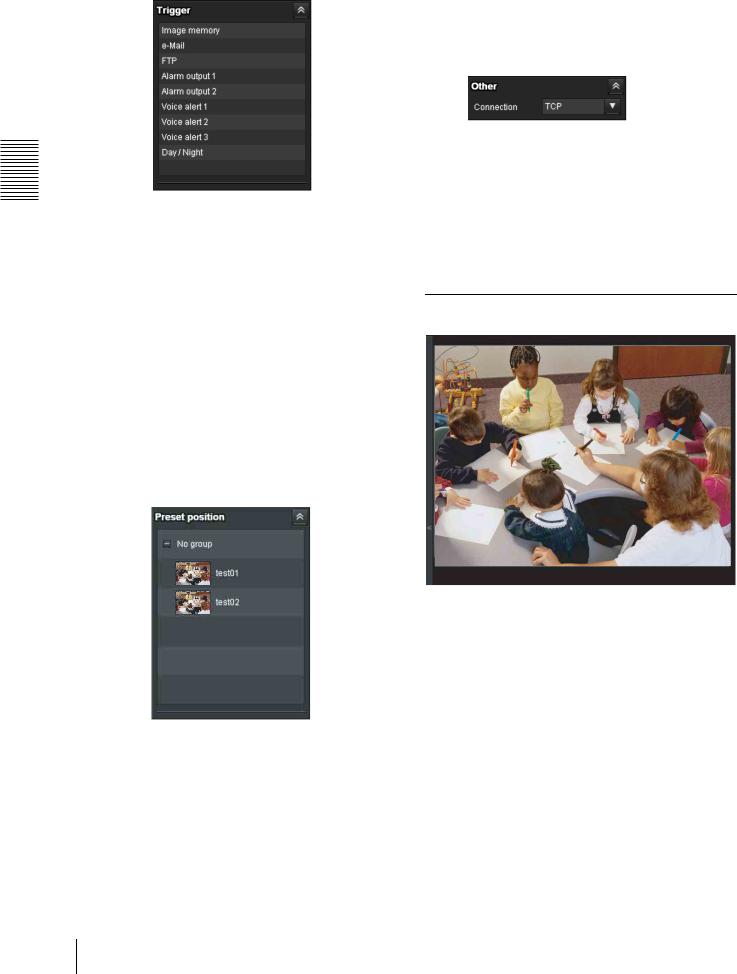
Trigger panel
|
The above is displayed only when Viewer mode |
||
|
|||
|
|||
Operating |
(page 63) is set to Full, and one or more triggers are |
||
enabled in the Trigger menu (page 83). |
|||
|
|||
the |
The configured functions are displayed as buttons on |
||
this panel. |
|||
Camera |
|||
Click the function button you want to use on the Trigger |
|||
|
|||
|
panel. The selected function is activated. The selectable |
||
|
functions are as follows: |
||
|
• |
send still image files attached to an e-mail (page 20) |
|
|
• |
send still image files to an FTP server (page 20) |
|
|
• |
Record still image files (page 20) |
|
|
• control the alarm output (page 21) |
||
|
• switch the Day/Night function on/off (page 21) |
||
|
• |
play the audio file stored in the camera (page 21) |
|
Preset position panel
The above is displayed only when one or more preset positions are stored in memory.
The registered preset position is displayed.
If you select a thumbnail when registering a preset position, it will be displayed with a thumbnail.
Select the Preset position name from the list. The camera will move to the preset position that you have stored in memory using the Preset position menu.
Others panel
(The Other panel is displayed in the case of an MPEG4 or H.264 image.)
You can switch between TCP and UDP (Unicast/ Multicast).
Each click switches the transmission mode of the video/ audio data between TCP mode, Unicast mode, and Multicast mode (page 21).
Monitor image
The image shot by the camera is shown here. There are two modes for on-screen pan/tilt/zoom
operation using a mouse: Area zoom mode and Vector dragging mode.
In the Area zoom mode, clicking will pan or tilt the camera towards the center of the image. The Area zoom will move the camera in the direction that displays the area selected by the operator and zooms in at the same time. The operator can choose a part of the image to view and zoom in by surrounding an area with a frame by dragging the mouse.
In the Vector dragging mode, the camera pans or tilts in the dragged direction. How long you drag the mouse determines the speed. Releasing the button on the mouse after dragging stops the panning or tilting of the camera. You can also use the camera control panel bar to pan or tilt.
The zoom operation using the mouse wheel is available in all modes.
16 Configuration of Main Viewer
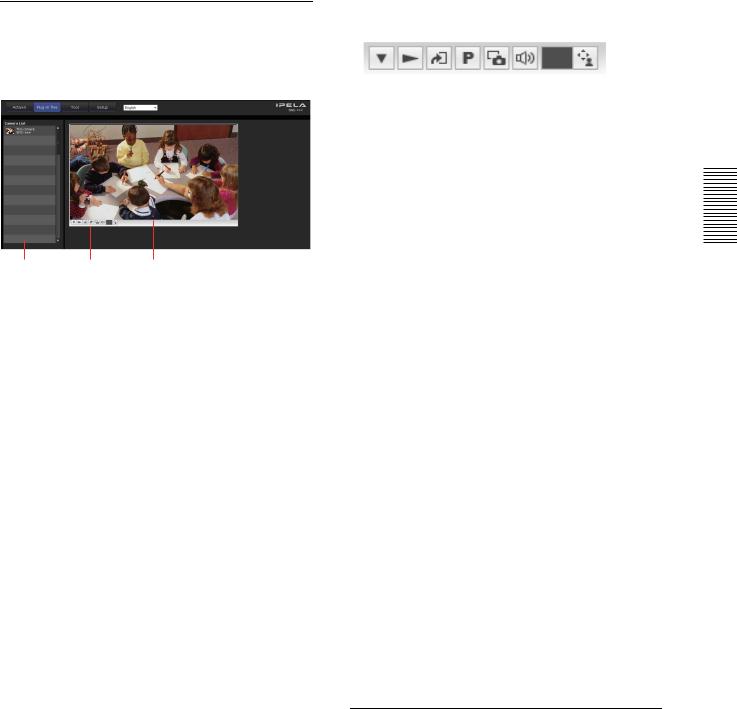
Plug-in free viewer
Main viewer using Plug-in free viewer
Display sample:
Camera list Control bar Monitor screen
Monitor screen
There are two modes for on-screen pan/tilt/zoom operation using a mouse: Area zoom mode and Vector dragging mode. A control bar is displayed on the screen. In the Area zoom mode, clicking will pan or tilt the camera towards the center of the image. The Area zoom will move the camera in the direction that displays the area selected by the operator and zooms in at the same time. The operator can choose a part of the image to view and zoom in by surrounding the area with a frame by dragging the mouse.
In the Vector dragging mode, the camera pans or tilts in the dragged direction. How long you drag the mouse determines the speed. Releasing the button on the mouse after dragging stops the panning or tilting of the camera. You can also use the tool bar to pan or tilt.
The zoom operation using the mouse wheel is available in all modes.
Control bar
The following operation buttons are available.
 Setting
Setting
You can set the streaming method, image size, frame rate, PTZ operation mode, trigger selection and image codec.
 Streaming start button
Streaming start button
Starts streaming. (Appears while stops streaming.)
 Streaming stop button
Streaming stop button
Stops streaming. (Appears while streaming.)
 Trigger run button
Trigger run button
Runs the selected trigger.
(Displayed only when Viewer mode from User menu (page 63) is set to Full, and one or more triggers are enabled in the Trigger menu (page 83).)
 Preset
Preset
Select a preset position to move the camera to the registered preset position.
(Displayed only when a camera preset position is registered.)
 Save still image button
Save still image button
Captures still images taken by the camera and saves them to the computer.
 Audio output volume slider
Audio output volume slider
Use the slider to adjust the volume. Clicking the button will stop sound output.
(Displayed only when ActiveX is set for
Streaming method in Setting, and Audio codec in the Camera Menu (page 33) is set to On.)
 Control waiting time and control time for exclusive control
Control waiting time and control time for exclusive control
 Exclusive control button
Exclusive control button
Camera list
The camera list is displayed when Camera list is set to On in the viewer menu, and at least one camera is registered.
Using Solid PTZ function
You can operate the camera by using the Solid PTZ function, which provides panning, tilting and zooming by adjusting the position and zooming ratio from the maximum image size (1280 × 720 or 1280 × 1024 (SNC-CH180/DH180/CH135/CH140/DH140), 1920 × 1080 or 1920 × 1440 (SNC-CH240/DH240/CH280/ DH280) (page 30)), without moving the camera. There are three modes of camera operation: Area zoom mode,
Vector dragging mode and PTZ Control bar. You can control pan/tilt and zoom in either mode.
Camera the Operating
Configuration of Main Viewer |
17 |
|
|
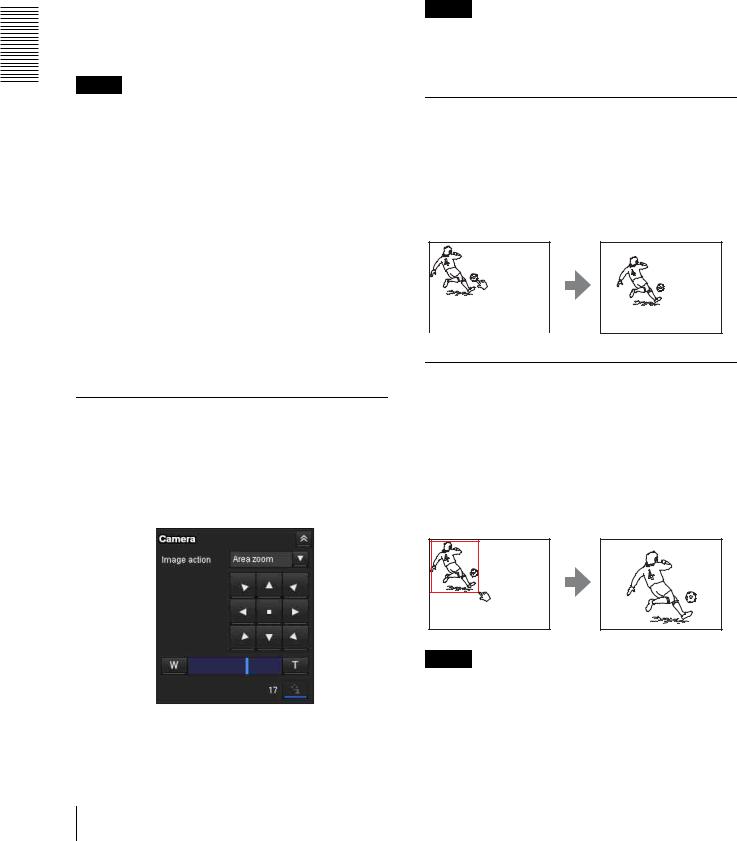
Camera the Operating
The available functions for the camera operation modes vary according to the viewer display. The available functions are as follows:
|
ActiveX |
|
|
Plug-in free viewer |
||
|
|
|
|
|
|
|
|
|
JPEG |
|
JPEG/ |
ActiveX |
|
|
viewer |
|
||||
|
|
|
|
|
Flash |
|
|
|
|
|
|
|
|
Operation from |
a |
× |
|
× |
× |
|
control panel |
|
|
|
|
|
|
|
|
|
|
|
|
|
Area zoom |
a |
a |
|
a |
a |
|
|
|
|
|
|
|
|
Vector dragging |
a |
a |
|
a |
a |
|
|
|
|
|
|
|
|
PTZ control bar |
× |
|
a |
|
a |
× |
|
|
|
|
|
|
|
Notes
•Pan/Tilt limitation
The solid PTZ function controls streaming by cropping or reducing a maximum size image.
Thus, the more the camera zooms out, the less area to be panned or tilted, and becomes unavailable at the WIDE setting.
•Zoom limitation
The solid PTZ function enables you to display an area of 1/16 the maximum image size (Aspect ratio: 1:4), when zoomed in at the TELE setting.
An image cannot be enlarged beyond this.
And the whole area shot in the maximum image size will be displayed if the camera is zoomed out at the WIDE setting.
The solid PTZ function’s zoom is performed digitally; therefore, some deterioration in image quality may be observed at the TELE setting.
Controlling via the control panel (Operation common to Area zoom mode and Vector dragging mode)
You can operate the camera direction, zoom, and focus by using the control panel for the monitor image currently displayed.
Pan/Tilt control
Click the arrow button in the direction in which you want to move the camera. Keep it pressed to move the camera continuously.
To return to the home position, click  .
.
Zoom control
Click  to zoom out, and click
to zoom out, and click  to zoom in. Zooming continues while the button remains pressed.
to zoom in. Zooming continues while the button remains pressed.
Note
The four edges of the image may be dark depending on the zoom position. This is a phenomenon related to the structure of the camera, and does not cause a problem.
Panning and tilting by clicking the monitor image (Area zoom mode only)
Click on the monitor image, and the camera moves so that the clicked portion is positioned at the center of the display.
Panning, tilting and zooming by specifying the area (Area zoom mode only)
Click and hold the left button of the mouse on the monitor image, and drag the mouse diagonally to draw a red frame around the portion you want to enlarge. The camera moves so that framed portion is positioned at the center of the display and is zoomed in.
Note
When the specified area is zoomed in, the center may be shifted or some portion of the image may appear out of the monitor image section. In this case, click the point you want to move to the center or click the arrow button on the camera control panel.
18 Configuration of Main Viewer

Panning and tilting by dragging the screen (Vector dragging mode only)
When you click on the starting point on the image and drag to the end point, the camera pans/tilts in the direction of the arrow from the starting point to the end point. The speed of operation is determined by the length of arrow. Releasing the button on the mouse stops the panning/tilting of the camera.
Moving the camera to a preset position (Common operations in Area zoom and Vector dragging modes)
Select a preset position name from the Preset position panel. The camera will move to the preset position that you have stored in memory using the Preset position menu (page 65).
Multiple preset positions can be organized by group according to setting.
Using pan/tilt/zoom operations with the displayed control bar (PTZ Control bar only)
Pan/Tilt operations
Click the arrow of the direction you wish to move the camera. Continue clicking on the arrow to keep moving the direction of the camera.
Zoom operation
Click  to zoom out, click
to zoom out, click  to zoom in. The zoom operation continues while you are clicking on the button.
to zoom in. The zoom operation continues while you are clicking on the button.
Controlling the Camera on a Full Image
When the camera is in controllable condition, the full image appears on the panorama panel.
The full image is the still image of entire area to be shot by the camera in reduced-sized image. By clicking on the full image, the selected location appears on the panorama panel.
To create a full image
Create the full image with Capture full image in the Initialize tab of the System menu. See page 32 for details.
Tip
Make sure to recreate the full image when you move the camera position or change the layout around the camera.
To display a specified position on the monitor
1 Create the full image and display on the monitor.
2 Click the potion you want to see on the full image.
Camera the Operating
Configuration of Main Viewer |
19 |
|
|

The current specified position appears on the monitor screen.
Camera the Operating
Using the Trigger Button
You can execute various functions by clicking their respective buttons on the Trigger panel.
Sending a monitor image via e-mail
You can send a captured still image by attaching it to an e-mail.
To use this function, you need to make e-Mail (SMTP) active and set the address in the Trigger menu of the Administrator menu properly (page 83).
1 Click e-Mail (SMTP) on the Trigger panel.
The still image of the moment you click is captured, and your e-mail with the image file attached is sent to the specified mail address.
Sending a monitor image to an FTP server
You can send a captured still image to the FTP server. To use this function, you need to make FTP active and set the address in the Trigger menu of the Administrator menu properly (page 84).
1 Click FTP client on the Trigger panel.
The still image of the moment you click is captured, and the image file is sent to the FTP server.
Recording a camera image as a still image
You can capture a camera image as a still picture and record it.
SNC-CH240/CH135/CH140/CH180/CH280 can record images in its built-in memory or CF memory card (not supplied). SNC-DH240/DH140/DH180/DH280 can only record images in its built-in memory.
To use this function, you need to make Image memory active and set the details in the Trigger menu of the Administrator menu (page 84).
1 Click Image memory on the Trigger panel.
The still image of the moment you click is captured, and the image file is recorded.
20 Using the Trigger Button
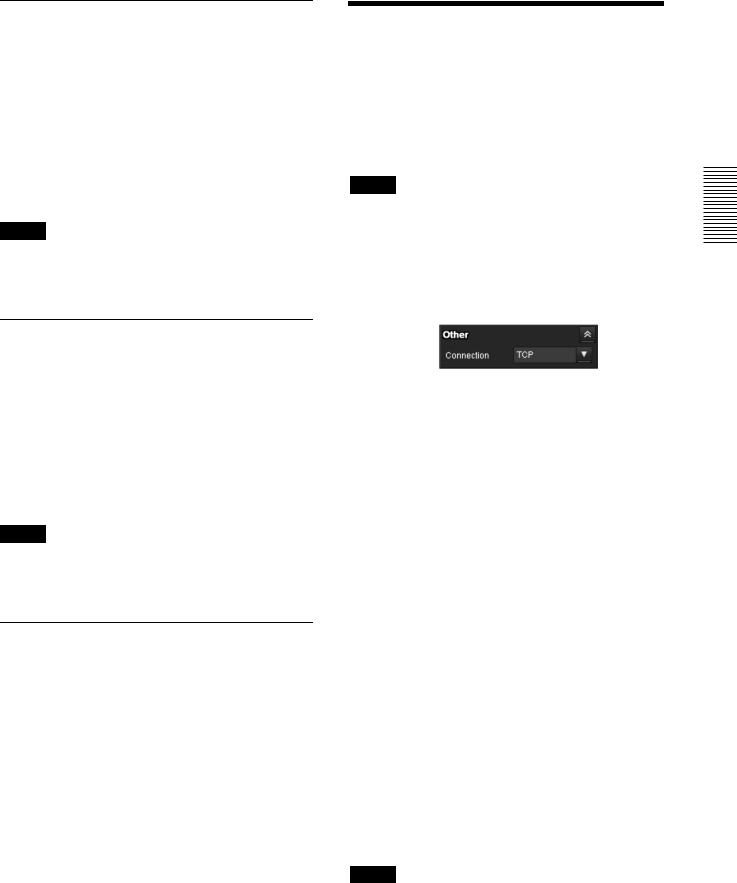
Controlling Alarm out 1, 2
You can control Alarm out 1, 2.
To use this function, you need to make Alarm out 1 or Alarm out 2 active in the Trigger menu of the Administrator menu (page 84).
1 Click Alarm out 1 or Alarm out 2 on the Trigger panel.
The alarm output is switched by clicking. The alarm output mode can be selected from
Toggle or Timer of Alarm out 1, 2 in the Trigger menu (page 84).
Tip
For the connection of peripheral devices to the alarm output of the I/O port, see the supplied Installation Manual.
Controlling the Day/Night function
You can set the Day/Night function to On (night mode) and Off (day mode).
To use this function, you need to make Day/Night active in the Trigger menu of the Administrator menu
(page 84).
1 Click Day/Night on the Trigger panel. Each click switches the Day/Night function
alternately between On (night mode) and Off (day mode).
Note
If Day/Night in the Trigger-Day/Night menu (page 84) is set to Auto, you cannot control the Day/Night function by clicking Day/Night.
Playing an audio file stored in the camera
You can play an audio file previously stored in the camera using the SNC audio upload tool.
To use this function, you need to make Voice alert1,
Voice alert2 and Voice alert3 active in the Trigger menu of the Administrator menu (page 84).
1 Click Voice alert1, Voice alert2 or Voice alert3 on the Trigger panel.
Playback of the selected audio file starts and the playback sound is output from the speaker connected to the camera.
Switching Transmission
Mode
You can change the transmission mode for video/audio data.
This function can be used when Mode (video codec mode) is set to MPEG4 or H.264 and the ActiveX viewer is used.
Note
The function may not operate correctly if you use personal firewall software or antivirus software on your computer. In that case, disable the software or select the TCP mode.
1 Select TCP, Unicast or Multicast from the
Connection drop-down list in the Others panel.
TCP: This is normally selected.
When TCP is selected, HTTP communication is adopted for video/audio communications. HTTP is the protocol used for reading the usual Web page. In an environment capable of reading Web pages, you can watch or listen to video/audio by selecting the TCP port.
Unicast: When Unicast is selected, RTP (Realtime Transport Protocol) is adopted for video/audio communications. Since RTP is the protocol for running video/audio data, the video/audio playback is smoother than when TCP (HTTP) is selected. If a firewall is installed between the camera and the computer, or depending on the network environment, video/audio may not play back properly when Unicast is selected. In this case, select TCP.
Multicast: This protocol is selectable when
Multicast streaming (page 42) is On. When
Multicast is selected, RTP (Real-time Transport Protocol) and UDP multicast techniques are adopted for video transmission. By selecting it, the network transmission load of the camera can be reduced. If a router that does not correspond to a multicast or firewall is installed between the camera and the computer, video/audio may not play back properly. In this case, select TCP or Unicast.
Note
When connecting via a proxy server, neither Unicast nor Multicast can be selected.
Camera the Operating
Switching Transmission Mode |
21 |
|
|
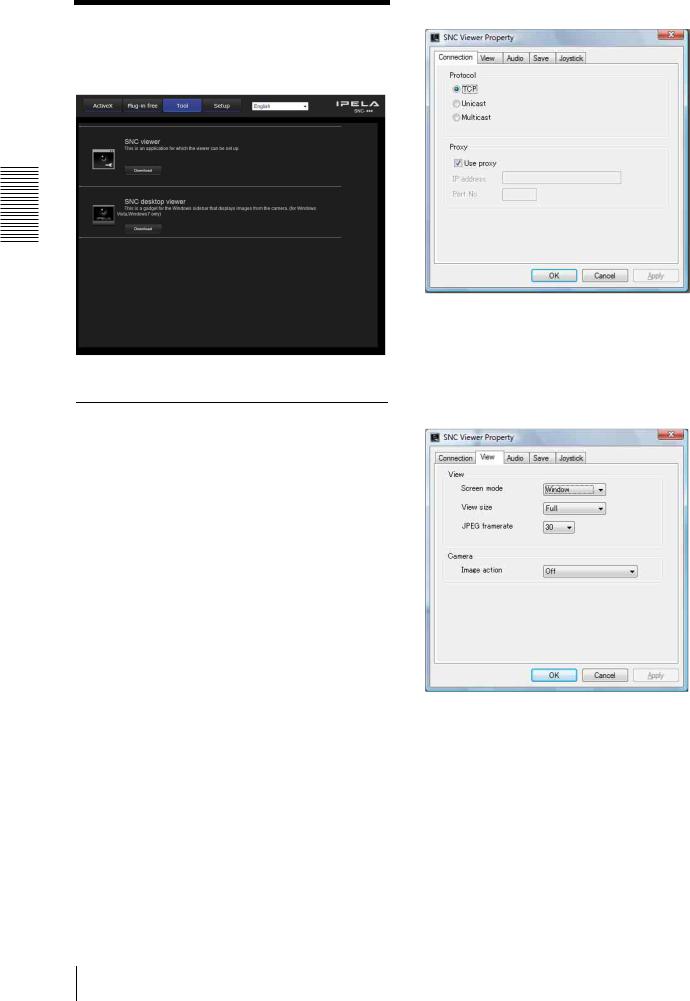
Using the System Utility
You can download system utility from the tools tab on the main menu.
Camera the Operating
To use the utility, click Download to begin download.
SNC viewer
SNC viewer is an application which allows you to set the initial state of the viewer.
Installing the SNC viewer
1 Execute the downloaded SNCViewer.msi file.
2 Install the SNC viewer following the instructions on the wizard.
When the license agreement policies are displayed, agree after reading them carefully and install the SNC viewer.
Using the SNC viewer
Click SNC viewer in the control panel.
Connection tab
You can set the connection method.
Select the start-up connection from: TCP, Unicast, and
Multicast.
If TCP connection is selected, you can configure proxy settings by selecting Use proxy.
View tab
Screen mode
You can select Window or Fullscreen.
View size
You can select the view size.
JPEG framerate
You can set the frame rate for JPEG.
Image action
Select from the image operation modes Area zoom,
Vector dragging and Off.
22 Using the System Utility
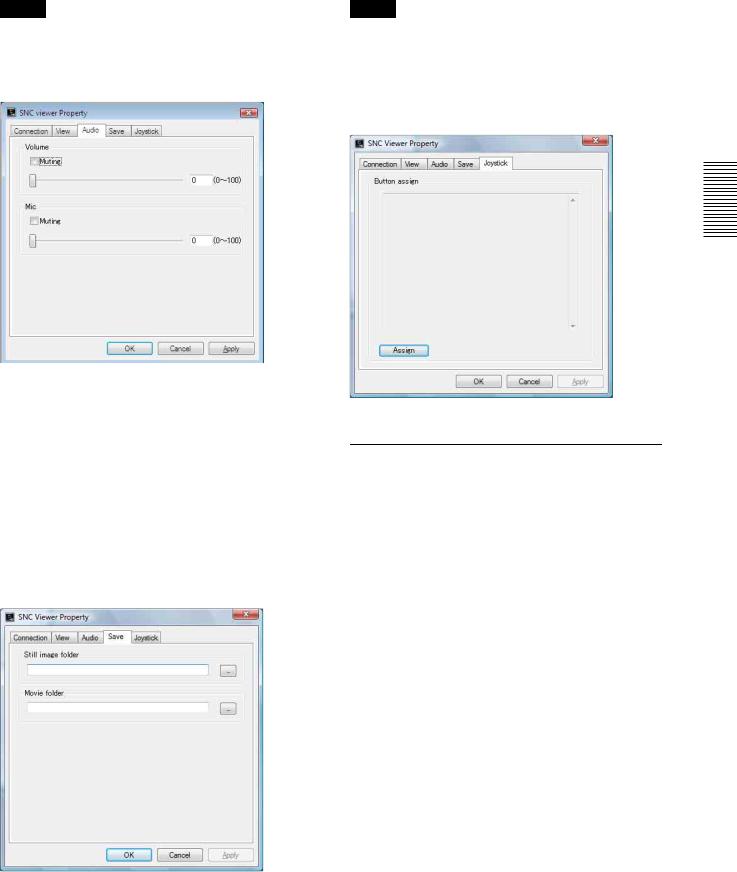
Tip
The operation mode of Solid PTZ have been changed for this device.
Audio tab
Volume
Muting: Select this option for Muting the sound at start-up.
Use the slide bar to set the volume for start-up sound output.
Mic
Muting: Select this option for Muting the microphone sound at start-up.
Use the slide bar to set the volume for start-up microphone input.
Save tab
Specify a folder to save the still images and movies to.
Note
In the case of Windows Vista, Windows 7, Windows 8 or Windows 8.1, if “Enable Protected Mode” is checked in Control Panel-Internet Option-Security, still images cannot be shot and video content cannot be saved.
Joystick tab
You can assign the joystick buttons here.
SNC Desktop viewer
The gadget that displays the camera image on the side bar of Windows Vista or Desktop in the case of Windows 7.
Installing the SNC desktop viewer
1 Click Download.
When the license agreement policies are displayed on the SNC desktop viewer download screen, agree after reading them carefully and download the SNC desktop viewer.
2 Click Save.
Save SncDesktopViewer.gadjet in the specified location.
3 Click Open files.
Run it in the “Download completed” dialog.
4 Click Run.
The message “Do you want to run this software?” will be displayed. Agree and run.
5 Click Install.
The message “Do you want to install this Gadget?” will be displayed. Agree and run.
Camera the Operating
Using the System Utility |
23 |
|
|
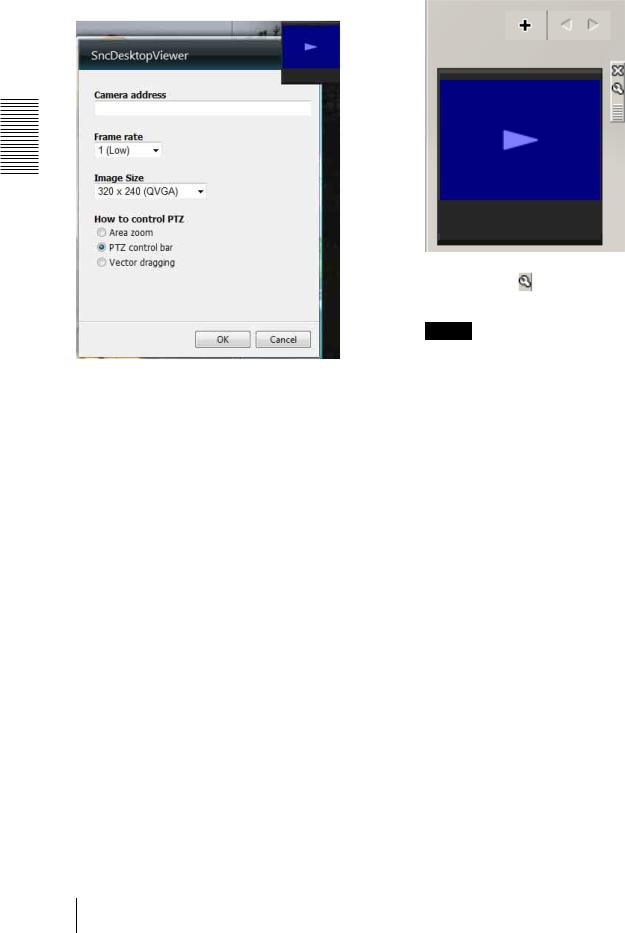
Using the SNC desktop viewer
When installation is finished, SNC desktop viewer is displayed on the side bar of Windows Vista or Desktop in the case of Windows 7.
Camera the Operating
Camera address
Set the IP address for the camera to display on the Gadget.
Frame rate
Select the frame rate for the image to display on the Gadget.
Image size
Select the image size for the image to display on the Gadget.
How to control PTZ
Select the PTZ operation mode for the Gadget screen from the options Area zoom, PTZ control bar, and Vector dragging.
Click  (Exit) to exit Gadget.
(Exit) to exit Gadget.
When you click (Set), you will see the following setting screen.
Tip
The operation mode of Solid PTZ has been changed for this device.
24 Using the System Utility
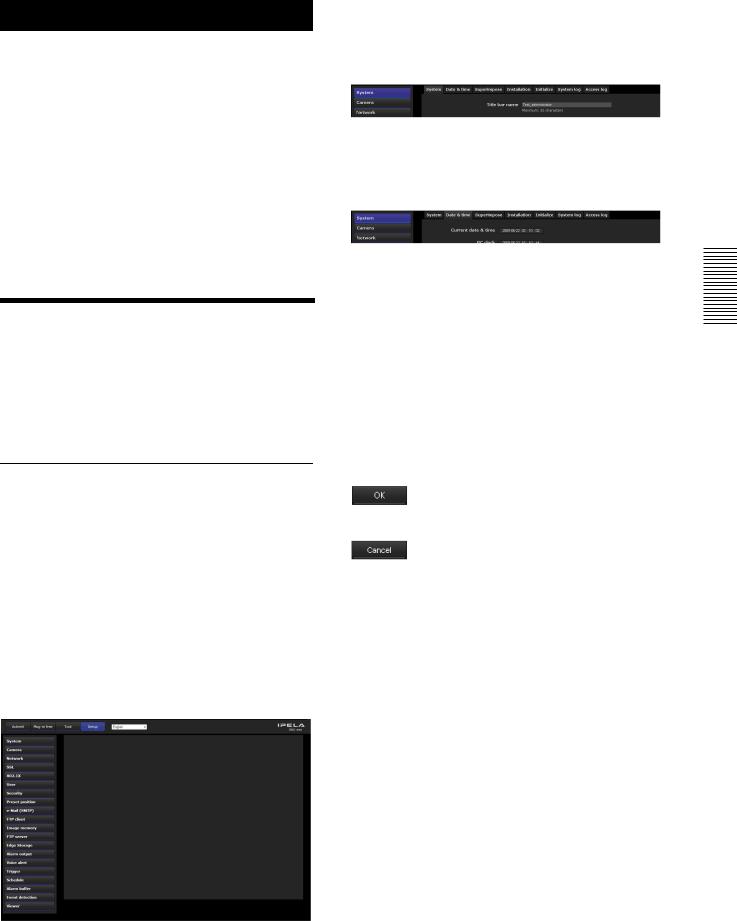
Administrating the Camera
This section explains how to set the functions of the camera by the Administrator.
For details about monitoring the camera image, see “Operating the Camera” on page 12.
This section explains the basic operations and each option of the Administrator menu.
Note on the display of menu options
The setting menus of this unit will clearly display only the setting options that you can currently select. Grayed out options cannot be selected.
Only supported functions are displayed.
Basic Operations of the
Administrator Menu
You can use the Administrator menu to set all functions to suit the user’s needs.
Click Setting in the viewer to display the Administrator menu.
How to set up the Administrator menu
1 Log in to the homepage to display the viewer. For details, see “Logging in as a user” on page 13.
2 Click Setting on the main menu.
The authentication dialog appears. Enter the user name and password for Administrator.
The user name “admin” and password “admin” are set at the factory for the Administrator.
The Administrator menu appears.
Change the password from the factory setting for the security of your devices.
3 Click the menu name (example: System) on the left side of the Administrator menu.
The clicked menu appears.
Example: “System” menu
4 Select the required tab above the menu, and set each setting option in the tab.
Example: “Date & time” tab of “System” menu
See pages 27 to 97 for details of the menu tabs and setting options.
5 After setting, click OK.
The settings you have made become active.
Click Cancel to nullify the set values and return to the previous settings.
Buttons common to every menu
The following buttons are displayed on all the menus. The functions of the buttons are the same on every menu.
Click this button to confirm the settings.
Click this button to nullify the set values and return to the previous settings.
General notes on menus
•One-byte katakana character is not valid for any text field, such as User name.
•After changing a setting on a menu, wait at least 30 seconds before turning off the power of the camera. If the power is turned off immediately, the new setting may not be stored correctly.
•If the camera settings are changed while watching the main viewer, some settings cannot be restored. To reflect the change on the opening main viewer, click Refresh on the Web browser.
Camera the Administrating
Basic Operations of the Administrator Menu |
25 |
|
|
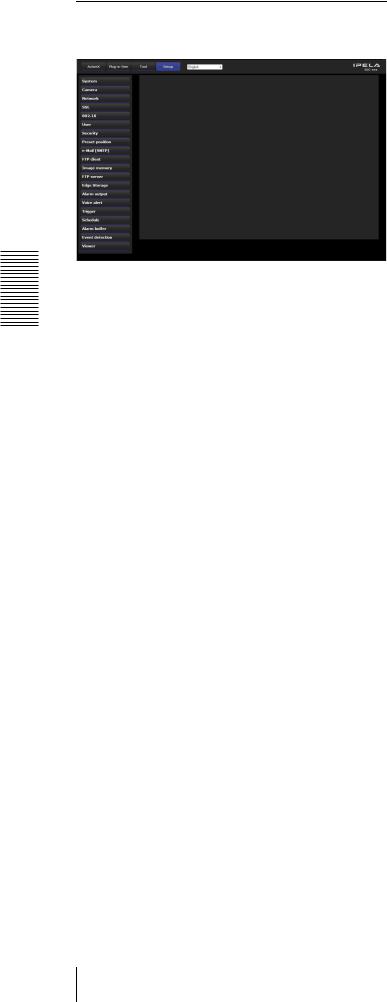
Configuration of the Administrator menu
System
Displays the System menu. (“Configuring the System
— System Menu” on page 27).
Administrating |
Camera |
|
|
|
Displays the Camera menu for setting the camera image |
|
and audio. (“Setting the Camera Image and Audio — |
the |
Camera Menu” on page 33). |
|
|
Camera |
Network |
|
|
|
Displays the Network menu for setting the network |
|
connection. (“Configuring the Network — Network |
|
Menu” on page 43). |
|
SSL |
|
Displays the SSL menu for performing SSL |
|
communication between the client device and camera. |
|
(“Setting the SSL function — SSL Menu” on page 51) |
|
802.1X |
|
Displays the 802.1X menu for connecting the camera to |
|
a network configured in compliance with the 802.1X |
|
standard for port authentication. (“Using the 802.1X |
|
Authentication Function — 802.1X Menu” on page 56) |
|
User |
|
Displays the User menu for setting the log in user name |
|
and password. (“Setting the User — User Menu” on |
|
page 62) |
|
Security |
|
Displays the Security menu for specifying a computer |
|
that is allowed to connect to the camera. (“Setting the |
|
Security — Security Menu” on page 63) |
Preset position
Displays the Preset position menu to register a position you want to save. “Tour function,” which rotates the registered positions, is also set here. (“Saving the Camera Position and Action — Preset position Menu” on page 65)
e-Mail (SMTP)
Displays the e-Mail (SMTP) menu for sending an e- mail. (“Sending an Image via E-mail — e-Mail (SMTP) Menu” on page 68)
FTP client
Displays the FTP client menu for sending an image/ audio file, etc., to an FTP server. (“Sending Images to FTP Server — FTP client Menu” on page 71)
Image memory
Displays the Image memory menu for recording an image/audio file, etc. (“Recording Images in Memory
— Image memory Menu” on page 74)
FTP server
Displays the FTP server menu for setting the FTP server function of the camera. (“Downloading Images from the Camera — FTP server Menu” on page 79)
Edge Storage
Set the recording of image and sound and stream them with the same protocol in Edge Storage menu. (“Setting the Edge Storage — Edge Storage Menu” on page 79)
Alarm output
Displays the Alarm output menu for setting the alarm output terminal of the camera. (“Setting the Alarm Output — Alarm output Menu” on page 81)
Voice alert
Displays the Voice alert menu for playing an audio file stored in the camera in synchronization with alarm detection by the sensor input or the motion detection function. (“Outputting Audio Linked to Alarm Detection — Voice alert Menu” on page 82)
Trigger
Displays the Trigger menu for designating the operation to execute when you run a trigger. (“Setting the Operations from the Viewer — Trigger Menu” on page 83)
Schedule
Displays the Schedule menu for the Day/Night function, e-Mail (SMTP) function, FTP client function, Image memory function and Alarm output function, Voice alert function, etc. (“Setting the Schedule — Schedule Menu” on page 85)
26 Basic Operations of the Administrator Menu
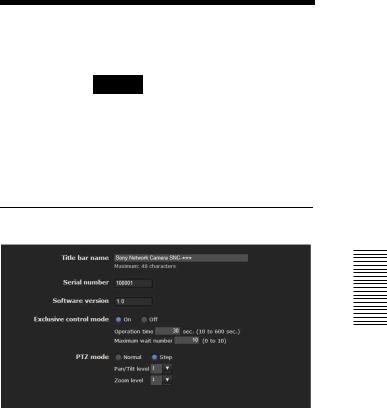
Alarm buffer
Displays the Alarm buffer menu for the buffer for storing the image and audio related to alarm detection. (“Setting the Alarm Buffer — Alarm buffer Menu” on page 86)
Event detection
Displays the setting menu for all built-in detection functions. (“Setting the Sensor input/Camera tampering detection/Motion detection/Audio detection — Event detection Menu” on page 86)
Viewer
Displays the Viewer menu from which you can select the viewer to use and configure advanced settings. (“Configuring the Viewer — Viewer Menu” on page 94)
Configuring the System
— System Menu
When you click System in the Administrator menu, the System menu appears.
Use this menu to perform the principal settings of the software.
The System menu has seven tabs: System, Date & time,
Superimpose, Installation, Initialize, System log and Access log.
System Tab
Title bar name
Type a name of up to 48 characters to be displayed on the title bar. The characters typed here are displayed on the title bar of the Web browser.
Serial number
The serial number of the camera is displayed.
Software version
The software version of this camera is displayed.
Exclusive control mode
Controls the authority to operate pan, tilt, zoom and some other functions of the camera.
On: Only one user has control authority. Set the operation time for one user in Operation time.
If a user tries to operate a function during operation by another user, the authority is controlled by the settings of Operation time and Maximum wait number.
Off: Multiple users can control pan, tilt and zoom at the same time. When multiple users control these functions at the same time, the last operation has priority.
Operation time
Sets the time length for a user who has control authority. The selectable range is from 10 to 600 seconds. This is effective when Exclusive control mode is set to On.
Camera the Administrating
Configuring the System — System Menu |
27 |
|
|
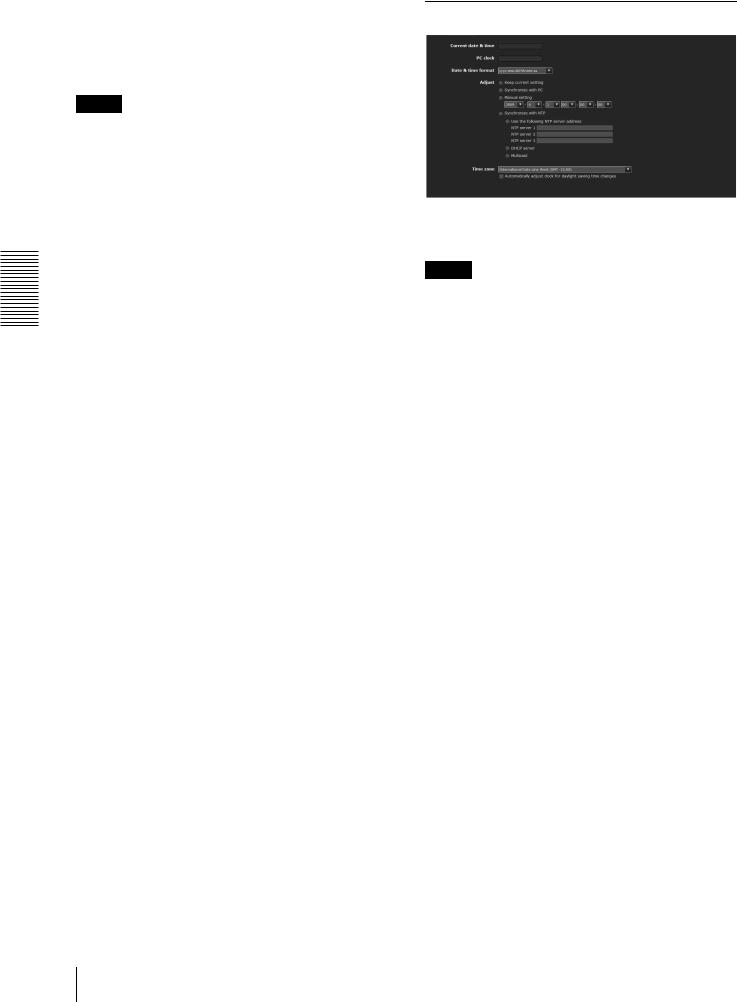
Camera the Administrating
Maximum wait number
Sets the number of users who are permitted to wait for their turn for control authority during operation by one user. The selectable number is from 0 to 10. This is effective when Exclusive control mode is set to On.
Notes
•To use Exclusive control mode, the date and time of the camera and the connected computer must be set correctly first.
•To use Exclusive control mode, do not disable the Web browser Cookie. If it is disabled, this mode cannot be used.
•When you change the Exclusive control mode setting, click Refresh on the Web browser to reflect the change when opening the main viewer page.
PTZ mode
Select the pan/tilt control mode using the 8-direction arrow buttons (page 18) and the zoom control mode using the  /
/  buttons (page 18).
buttons (page 18).
Select Normal or Step.
Normal: When you click the mouse button, the camera starts panning, tilting or zooming, and the operation continues while you hold down the mouse button. To stop the operation, release the mouse button.
Step: Each time you click the mouse button, the camera moves (pans, tilts or zooms). If you keep the mouse button held down for more than 1 second, the operation mode is temporarily changed to Normal. When you release the mouse button, camera operation stops and the Step mode is restored.
When you select Step, Pan/Tilt level and Zoom level are selectable.
Pan/Tilt level: Select the camera transition level from 1 to 10 by clicking the 8-direction arrow buttons for panning/tilting. Selecting 10 provides the maximum transition level.
Zoom level: Select the camera transition level from 1 to 10 by clicking  /
/  for zooming. Selecting 10 provides the maximum transition level.
for zooming. Selecting 10 provides the maximum transition level.
OK/Cancel
See “Buttons common to every menu” on page 25.
Date & time Tab
Current date & time
Displays the date and time set on the camera.
Note
After you have purchased the camera, be sure to check the date and time of the camera and set as necessary.
PC clock
Displays the date and time set on your computer.
Date & time format
Select the format of date and time to be displayed in the main viewer from the drop-down list.
You can select the format between yyyy-mm-dd hh:mm:ss (year-month-day hour:minutes:seconds), mm-dd-yyyy hh:mm:ss (month-day-year hour:minutes:seconds), and dd-mm-yyyy hh:mm:ss (day-month-year hour:minutes:seconds).
Adjust
Select how to set the day and time.
Keep current setting: Select if you do not need to set the date and time.
Synchronize with PC: Select if you want to synchronize the camera’s date and time with the computer.
Manual setting: Select if you want to set the camera’s date and time manually.
Select the year, month, date, hour, minutes and seconds from each drop-down list.
Synchronize with NTP: Select if you want to synchronize the camera’s date and time with those of the time server called NTP server (Network Time Protocol).
Set the NTP server when Synchronize with NTP is selected.
Use the following NTP server address: Synchronize with the selected NTP server address.
NTP server 1: Enter the first choice for NTP server address.
NTP server 2: Enter the second choice for NTP server address.
28 Configuring the System — System Menu
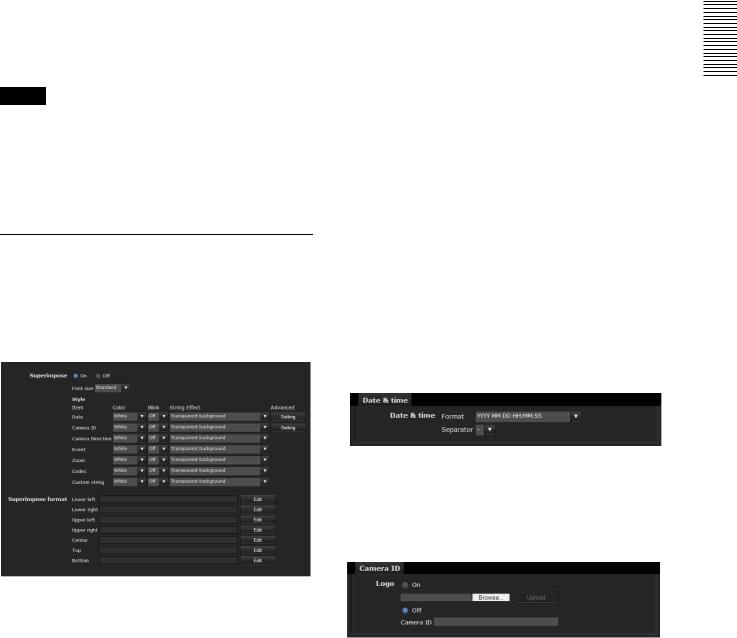
NTP server 3: Enter the third choice for NTP server address.
DHCP server: Select DHCP server when you need to get NTP server information from DHCP server.
Multicast: Select Multicast when you search for an NTP server with Multicast.
Time zone
Set the time difference from Greenwich Mean Time in the area where the camera is installed.
Select the time zone in the area where the camera is installed from the drop-down list.
For Japan, select “Osaka, Sapporo, Tokyo (GMT+9:00)”
Automatically adjust the clock for daylight saving time changes
When selected, the clock is automatically adjusted according to the daylight saving time of the selected time zone.
Note
If the time zone selected in Time zone is different from that set on the computer, the time is adjusted using the time zone difference and set on the camera.
OK/Cancel
See “Buttons common to every menu” on page 25.
Superimpose Tab
Select whether to superimpose the camera ID, date & time and other information on the image or not.
The camera ID is also superimposed on images recorded by the Pre-alarm or Post-alarm function.
Superimpose is applied to Image 1 and Image 2.
Superimpose
On/Off
When using the Superimpose function, select On.
Font size
Set the font size.
Style
Set the items to superimpose and the format to display in. English one byte characters and symbols are displayed. Superimpose settings are available for the following items:
•Date: Set the display settings for date and time.
•Camera ID: Set the display settings for Camera ID and string.
•Camera direction: Displays the name of a preset position.
•Event: Configure the display setting for when an event occurs.
•Zoom: Configure the zoom display.
•Codec: Configure the bit rate and frame rate display settings. Displays the codec information for Image 1.
•Custom string: Set Custom string to display the text of your choice.
Display format, including color, can be individually set for each item.
Color: Select the font color of the superimposed text. Blink: Select On to enable blinking for the
superimposed text. However, the blinking display is not available for Date.
String Effect: Enable a string effect for displayed text. Advanced: When you click the Setting button in Date, the Date & time menu is displayed and you can set
the necessary options.
Format: Select the format for date and time. Separator: Select the separator for time display.
When you click the Setting button in Camera ID, the Camera ID menu is displayed and you can set the necessary options.
Camera the Administrating
Configuring the System — System Menu |
29 |
|
|
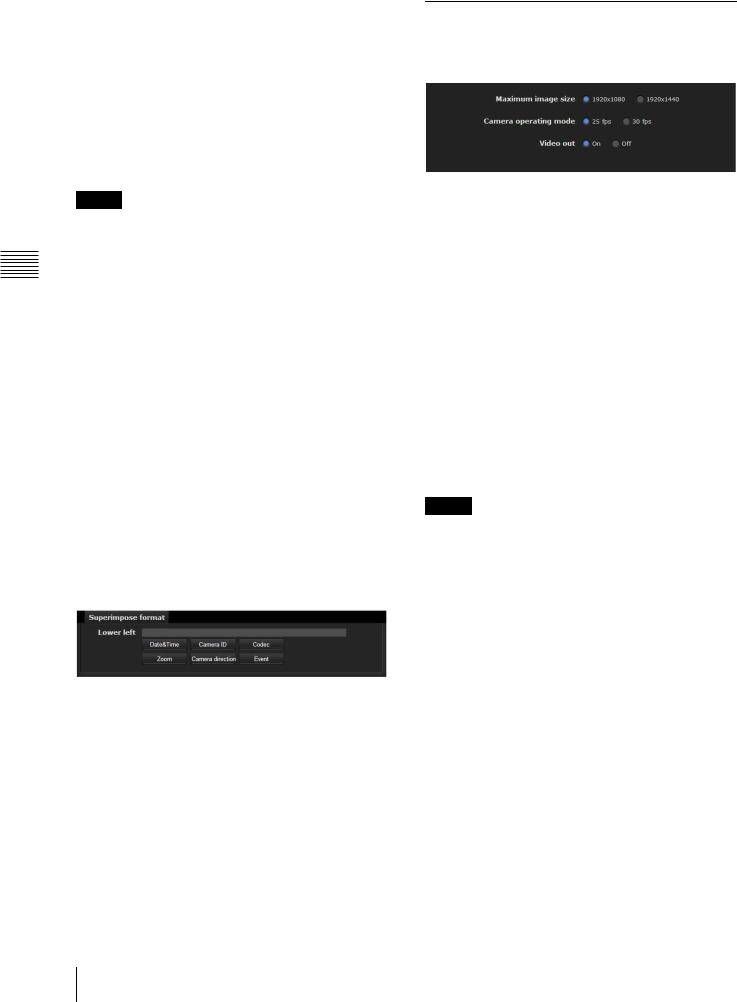
Logo
On: Select an image file you want to use for Logo by using the Browse... button, and click Upload to upload the file.
Supported image file format: gif89a format (GIF animation and transparent GIF format are not supported.)
Maximum image size: 640 × 120
Number of horizontal pixels: An even number
Maximum file size: Approximately 50 KB Off: You can set Text in Camera ID’s box.
Notes
•Both Text and Logo cannot be used at the same time.
•If the image size of the logo is larger than the image,
it cannot be displayed.
|
Superimpose format |
|
|
||
|
||
|
Click Edit to edit the content to superimpose over each |
|
|
||
|
||
|
||
|
||
|
display position. |
|
|
||
|
||
|
||
Administrating |
Only one Date and one Camera ID can be specified for |
|
the Superimpose format. |
||
|
||
|
You can set the content to superimpose in the “Lower |
|
|
left”, “Lower right”, “Upper left”, “Upper right”, |
|
the |
“Center”, “Top” and “Bottom” parts, respectively. |
|
However, if you specify the “Top”, superimposed |
||
Camera |
||
content will not appear on the upper left or upper right. |
||
|
||
|
Similarly, if you specify “Bottom”, superimposed |
|
|
content will not appear on the lower left or lower right. |
|
|
If the Lower left/Lower right or Upper left/Upper |
|
|
right are displayed at the same time, the maximum |
|
|
image size that can be used for a logo is 624 × 120. |
|
|
Click Date & Time, Camera ID, Codec, Zoom, |
|
|
Camera direction or Event to insert the corresponding |
|
|
tag into the string. |
|
|
Display sample: Lower left |
OK/Cancel
See “Buttons common to every menu” on page 25.
Installation Tab
You can perform settings related to installation.
Display sample: SNC-CH240
Maximum image size
SNC-CH135/CH140/CH180/DH140/DH180
1280 × 720: Image will have an aspect ratio of 16:9, and an image size up to 1280 × 720 can be specified for the video codec.
1280 × 1024: Image will have an aspect ratio of 5:4, and an image size up to 1280 × 1024 can be specified for the video codec.
SNC-CH240/DH240/CH280/DH280
1920 × 1080: Image will have an aspect ratio of 16:9, and an image size up to 1920 × 1080 can be specified for the video codec.
1920 × 1440: Image will have an aspect ratio of 4:3, and an image size up to 1920 × 1440 can be specified for the video codec.
Notes
•The camera restarts when the Maximum image size is changed. It takes about 2 minutes.
•The settings below are changed when the Maximum image size is changed.
–Camera menu-privacy mask tab: returns to the factory setting.
–Camera menu-video codec tab: returns to the factory setting except:
SNC-CH135/CH140/CH180/DH140/DH180
–Image size of image1: to be 1280 × 720 when set to 1280 × 720, or 1280 × 1024 when set to
1280 × 1024.
–Frame rate of image1: to be 30 fps when set to 1280 × 720, or 20 fps when set to 1280 × 1024.
SNC-CH240/DH240/CH280/DH280
–Image size of image1: 1920 × 1080 (when set to 1920 × 1080), or 1920 × 1440 (when set to 1920 × 1440).
–Frame rate of image1: 30 fps or 25 fps* (when set to 1920 × 1080), or 20 fps (when set to 1920 × 1440).
* Depending on the camera operating mode setting.
–Preset position menu: returns to the factory setting.
–Alarm buffer menu: returns to the factory setting.
30 Configuring the System — System Menu
